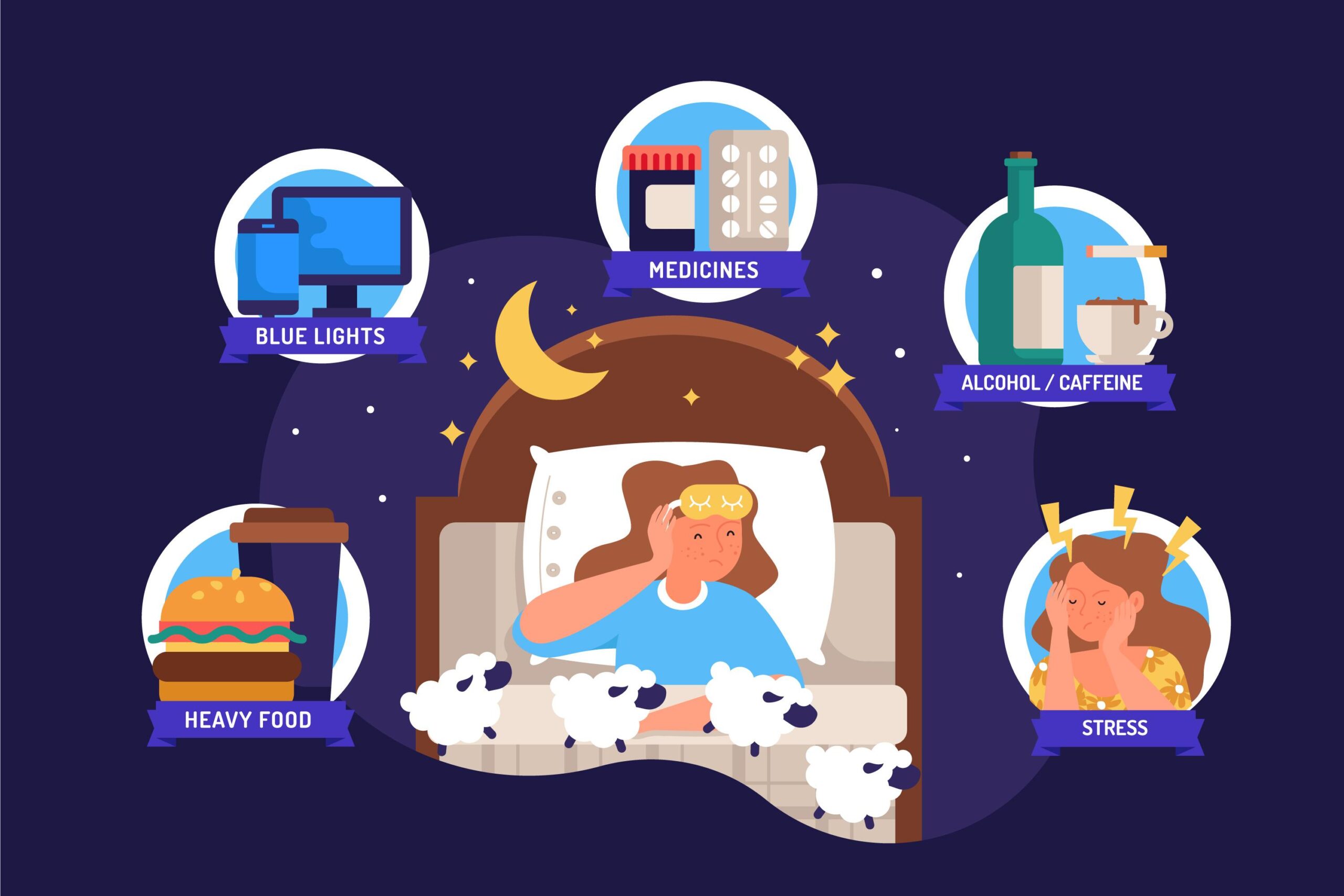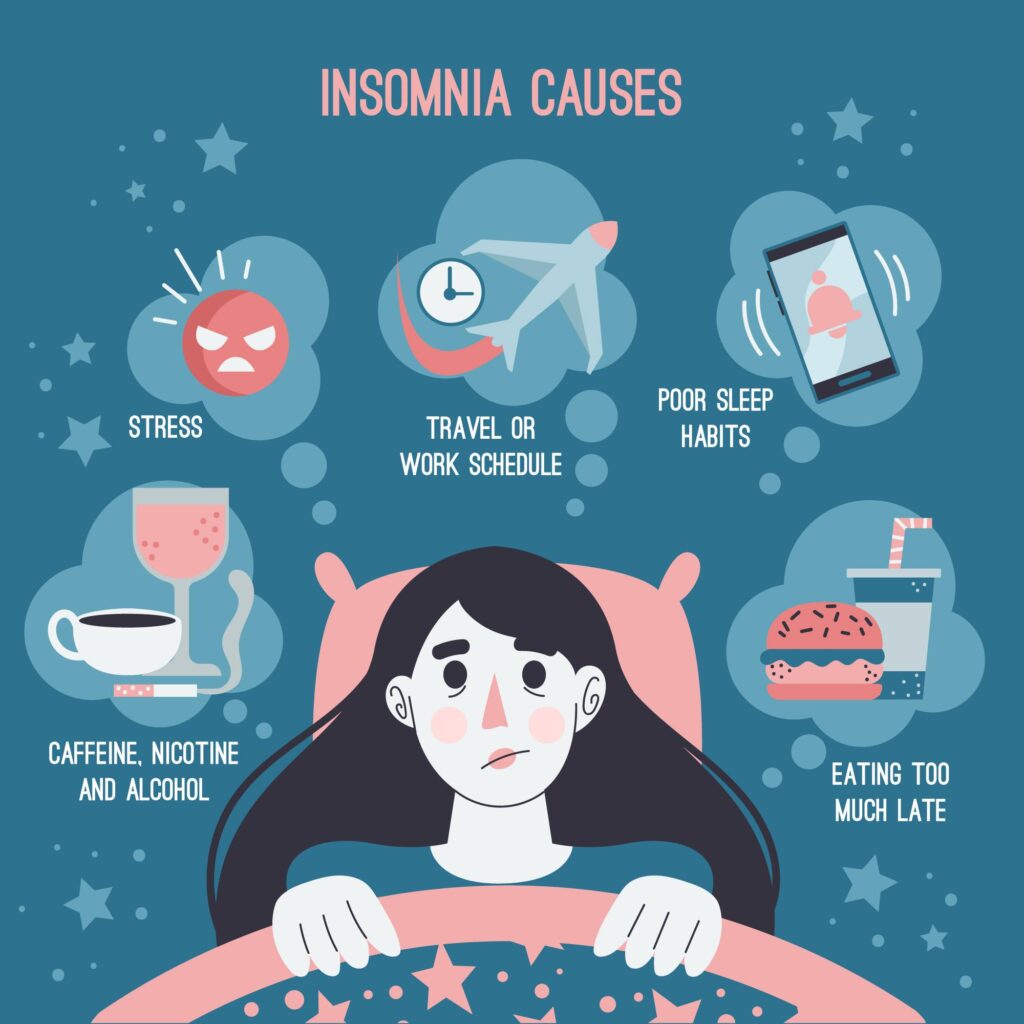Learn in-depth about the three types of sleep disorders. Know which sleep disorder you have?
In the bustling tapestry of life, sleep serves as the essential thread that weaves together our physical and mental well-being. However, for some individuals, the journey into the world of slumber is fraught with challenges that can disrupt the delicate balance of rest. In this blog, we embark on a comprehensive exploration of three types of sleep disorders – Sleep Apnea, Narcolepsy, and Insomnia – shedding light on their distinct characteristics and the profound impact they can have on one’s daily life.
Three types of sleep disorders
- Sleep Apnea
- Narcolepsy
- Insomnia

Sleep Apnea
Sleep apnea is a sleep disorder characterized by interruptions in breathing during sleep. These interruptions, known as apneas, can occur multiple times throughout the night and may last for seconds to minutes. The most common types of sleep apnea are obstructive sleep apnea (OSA), central sleep apnea, and a combination of both, referred to as complex sleep apnea syndrome.
1. Obstructive Sleep Apnea (OSA):
– Mechanism: OSA is the more prevalent form and occurs when the muscles at the back of the throat relax excessively, leading to a partial or complete blockage of the upper airway.
– Consequences: The blocked airway causes a temporary pause in breathing, leading to a decrease in oxygen levels in the blood. The brain then signals the body to awaken briefly to reopen the airway, often accompanied by a loud snort or gasp.
2. Central Sleep Apnea:
– Mechanism: Central sleep apnea results from a failure of the brain to transmit the necessary signals to the muscles responsible for controlling breathing.
– Consequences: Unlike OSA, there is no physical obstruction in the airway. Instead, breathing pauses because the brain fails to send the appropriate signals. Individuals with central sleep apnea may experience a more sudden cessation of breathing without the usual snoring associated with OSA.
Common Symptoms:
– Loud Snoring: Especially in obstructive sleep apnea.
– Abrupt Awakenings: Often accompanied by a choking or gasping sound.
– Excessive Daytime Sleepiness: Due to disrupted sleep during the night.
– Difficulty Staying Asleep: Frequent awakenings.
Risk Factors:
– Obesity: Excess weight, especially around the neck, can contribute to airway obstruction.
– Age: Sleep apnea becomes more common as individuals age.
– Gender: Men are more likely to experience sleep apnea than women.
– Family History: A family history of sleep apnea may increase the risk.
Diagnosis and Treatment:
– Polysomnography: A sleep study conducted in a sleep centre to monitor various physiological factors during sleep.
– Continuous Positive Airway Pressure (CPAP): A common treatment involving a machine that delivers a continuous stream of air to keep the airway open.
– Lifestyle Changes: Weight loss, positional therapy, and avoiding alcohol and sedatives before bedtime.
Narcolepsy
Narcolepsy is a neurological disorder characterized by disturbances in the brain’s ability to regulate sleep-wake cycles. Individuals with narcolepsy often face challenges in maintaining a normal sleep pattern, leading to excessive daytime sleepiness (EDS) and, in some cases, sudden and uncontrollable episodes of muscle weakness or paralysis known as cataplexy.
Common Symptoms:
1. Excessive Daytime Sleepiness (EDS):
– Description: Overwhelming and persistent sleepiness during waking hours, regardless of the amount of nighttime sleep.
– Consequences: Individuals with narcolepsy may struggle to stay awake and alert, impacting daily activities and overall quality of life.
2. Cataplexy:
– Description: Sudden and temporary loss of muscle tone, often triggered by strong emotions such as laughter, surprise, or anger.
– Consequences: Cataplexy can lead to slurred speech, weakness, or complete collapse, lasting for a few seconds to a few minutes. It distinguishes narcolepsy from other sleep disorders.
3. Hallucinations and Sleep Paralysis:
– Description: Vivid and often frightening dream-like experiences that occur during the transition between wakefulness and sleep.
– Consequences: Hallucinations may be visual or auditory, and sleep paralysis can temporarily immobilize the individual, making them unable to move or speak.
4. Fragmented Nighttime Sleep:
– Description: Individuals with narcolepsy may experience disrupted nighttime sleep, characterized by frequent awakenings or difficulties maintaining a deep and restful sleep.
– Consequences: Fragmented sleep contributes to the overall sleep disturbance seen in narcolepsy.
Causes:
– The exact cause of narcolepsy is not fully understood, but it is believed to involve a deficiency in the neurotransmitter hypocretin (orexin) in the brain.
– Narcolepsy has a genetic component, and certain environmental factors may contribute to its development.
Diagnosis and Treatment:
– Polysomnography and Multiple Sleep Latency Test (MSLT): Used to diagnose narcolepsy by measuring nighttime sleep patterns and assessing daytime sleepiness.
– Stimulant Medications: Prescribed to alleviate excessive daytime sleepiness.
– Antidepressant Medications: Used to manage cataplexy and other symptoms.
– Scheduled Naps: Strategic short naps during the day to help manage daytime sleepiness.
Insomnia
Insomnia is a prevalent sleep disorder characterized by difficulties in initiating or maintaining sleep, leading to poor sleep quality and potential daytime impairment. Individuals with insomnia often find it challenging to fall asleep, stay asleep throughout the night, or experience restorative sleep, despite having an adequate opportunity for sleep.

Common Features:
1. Difficulty Falling Asleep:
– Description: Individuals with insomnia may struggle to initiate sleep even when tired, leading to prolonged periods of wakefulness before eventually falling asleep.
– Consequences: This difficulty in sleep onset contributes to overall sleep disruption and may result in frustration and anxiety.
2. Frequent Awakenings:
– Description: Insomnia can manifest as waking up multiple times during the night, with individuals finding it challenging to maintain continuous sleep.
– Consequences: The frequent awakenings disrupt the natural sleep cycle, preventing the attainment of deeper, more restorative sleep stages.
3. Early Morning Awakenings:
– Description: Some individuals with insomnia may wake up earlier than desired and find it difficult to return to sleep, even if they have not rested sufficiently.
– Consequences: Early morning awakenings contribute to sleep deprivation and daytime fatigue.
4. Non-Restorative Sleep:
– Description: Even when individuals with insomnia do sleep, they often report feeling not refreshed or rested upon waking.
– Consequences: The perceived lack of restorative sleep contributes to daytime fatigue, irritability, and difficulties in concentration and memory.
Causes:
– Psychological Factors: Stress, anxiety, depression, and other emotional disorders can contribute to insomnia.
– Medical Conditions: Chronic pain, respiratory problems, and hormonal imbalances may disrupt sleep.
– Lifestyle Factors: Poor sleep hygiene, irregular sleep schedules, and excessive caffeine or alcohol consumption can contribute to insomnia.
Diagnosis and Treatment:
– Sleep Diary: Keeping a record of sleep patterns and habits can aid in diagnosis.
– Cognitive-Behavioral Therapy (CBT): A structured therapeutic approach that addresses thoughts, behaviours, and attitudes affecting sleep.
– Medications: In some cases, prescription or over-the-counter sleep aids may be recommended for short-term relief.
Timely identification and intervention are crucial for managing sleep disorders like sleep apnea, narcolepsy, and insomnia. Seeking consultation with a sleep specialist, such as Dr Nalin Joshi in Jaipur, ensures a thorough evaluation and personalized treatment plans. Early diagnosis helps prevent health complications and allows for tailored lifestyle adjustments and interventions. Reach out to “Sleep Disorder Treatment in Jaipur” to address your sleep concerns and embark on a path to better sleep and overall well-being.





